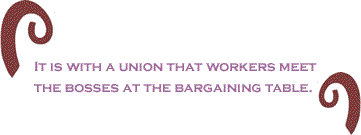The
so-called �right to work� laws got some attention this
week, when Indiana�s governor, Mitch Daniels, signed his
own state�s �right to work� law, making it the 23rd state
to enact laws that emasculate American workers in their
workplaces. These laws are a primary reason for the U.S.
decline in unionization of its workers and, coincidentally,
the nation�s economy has declined at a commensurate rate.
All
the while, the Corporate America-sponsored �Right to Work
Committee� and its legal defense fund for generations
have touted such laws as the right of workers to choose
whether they wish to join a union or not, and, therefore,
whether to pay dues to a union that represents them. In
any case, if there is a union in a workplace in a right-to-work
state, there is unrelenting pressure by the employer and
many fellow workers not to join and certainly not to pay
dues. But, in most places, the union is required to represent
all the workers, whether they pay dues or not. In other
words, the union-dues-paying workers foot the bill for
the free riders who get their representation for nothing.
Consequently,
the environment for unions in the right-to-work states
is not very friendly and the workers have to make do with
collective begging, rather than collective bargaining.
In the simplest terms, the corporations in right-to-work-for-less
states put more money into their own coffers and much
less into the paychecks of the workers, which means that
there is less money for the small businesses in their
communities where workers spend their money.
It
means that the educational systems are not as good, the
medical care (in a public health sense) is not as good,
and the so-called infrastructure (roads, bridges, water
and sewer systems, environmental protection) are not as
good. If you look at a map of �right-to-work� states,
you�ll be looking at a map of places where citizens can
expect less of everything that makes for a good quality
of life (notwithstanding that the American economy, in
general, is in trouble right now).

That�s
why knowledgeable American workers refer to the states
with lesser rights as �right-to-work-for-less� states.
You can look at it this way: there are the free states,
in which workers are free to join together to form a union
and there are those states in which the workers are not
free. Where there are unions, the workers have a democratic
process through their unions. They elect their local officers,
they tell their negotiating committee what is important
to them at the bargaining table, and they are free to
participate in the process in many ways that includes
running for office and taking a leadership role in representing
their fellow workers.
Try
running for president of the company from the shop floor
and see what it gets you. It just won�t happen. It is
with a union that workers meet the bosses at the bargaining
table, with some semblance of equality.
The
map of free states (union-possible states) and the �right-to-work-for-less�
states is clear-cut. With few exceptions, the unfree states
are the states where the disparity in income and wealth
is great and the historic problems of poverty, civil rights,
inequality in the political process, in education, and
in the securing of rights, in general, are present to
this day. That is not to say that there are not problems
of this sort in the free states, but there is no comparison
with the unfree states.
And,
it should be viewed in those stark terms: The �right-to-work�
states are states in which workers are not free to form
unions and represent themselves at the bargaining table
in what is a vital part of our national life, the economy.
The free states are those in which the workers are free
to represent themselves at the bargaining table, as more
or less equals to the bosses. It�s like free citizens
under a constitution like that of the U.S., compared with
subject people under a king or absolute ruler in some
developing country.
Daniels,
the Republican Indiana governor, a short time ago indicated
that he was not interested in the creation of a right-to-work-for-less
law, but he wasted no time signing one into law in the
past week, as if he wanted it to be an in-your-face welcome
to the two professional football teams that played in
his capital city last Sunday. Although some of the players
make more in a week than the average worker makes in a
year, they were in support of the workers who protested
the new law and made it clear that they were unhappy about
playing in a city and a state where workers who want a
union are not welcome.
The
�Right to Work Committee and its legal foundation are
constantly scheming to create lawsuits against unions
and union leaders and they seem to have unlimited money
to do so. Small wonder, since the money from these Astroturf
organizations is the same source of funds that brought
us the infamous U.S. Supreme Court decision in the Citizens
United case, in which a split court said that money
is speech and corporations are people, and nameless and
faceless political action committees can spend as much
money in political campaigns as they wish. The court decision
was a victory for Corporate America and the same kinds
of characters that push states into the backwaters of
history, as far as workers� rights are concerned.

What�s
interesting is that these are the same people who rail
against �entitlements,� such as Medicaid, any kind of
welfare program for the poor, and erroneously, Medicare
and Social Security. They don�t want to see anyone getting
�something for nothing,� even if they work 60 hours a
week at minimum wage. They do, however, want to see workers
living off the backs of their fellow workers who do
pay union dues and stand up for the rights of all workers.
That�s
something for nothing, just as the Republican frontrunner
for the presidential nomination, Mitt Romney, who rakes
in his money while doing nothing, famously said, �Corporations
are people, too, my friend,� to someone who demanded that
corporate money be removed from the political process.
American
trade unionists have been fighting for generations against
the theft of their country�s wealth by a small elite.
That�s why it should be gratifying for union men and women
to see the �Occupy� movement taking up the same issues
and expanding on them. There were bloody fights over the
same worker rights, even fights that verged on war, by
workers and their unions, against detective agencies (corporations�
private armies), gun thugs, and at times, the U.S. military.
The fight for an equitable share of the wealth of the
land has never stopped, and the �Occupy� movement has
picked up the banner. Now, it needs to join those who
have been struggling for economic and political equity
for many decades.
Back
in the 1930s, during the Great Depression when the plight
of workers was the worst, President Franklin D. Roosevelt
facilitated some profound changes, among them the National
Labor Relations Act (NLRA), which allowed and encouraged
the formation of unions, to both lift up workers and their
families, as well as bring their communities back to life.
Giving those rights to working people was a dangerous
thing, in the minds of the one-percenters of the time
and their fight against the full realization of workers�
aspirations began in earnest. The U.S. Chamber of Commerce
and many other representatives of the 1 percent have fought
as if it is their last fight�against the empowerment of
workers.

In
some ways, it is the biggest fight of the 1 percent.
Since passage of the NLRA, using various methods, in the
courts and in Congress and the state legislatures, powerful
corporate interests have succeeded in thwarting the spirit
of the NLRA. Using the ploy of the states� rights principle,
they were successful in getting federal lawmakers to grant
to the states the power to thwart both the spirit and
the letter of the NLRA. That�s how the ratio of CEO
pay and perks went from 24-1, to 250-1, compared with
average workers� pay, over just a few decades. An important
element in achieving this push of wealth to the top 1
percent has been right-to-work (for less) laws.
The
Occupy movement needs to spread the word that the U.S.
economy has descended in parallel with the decline in
the percentage of U.S. workers who are in unions. Others
on the left have known this for decades. Under U.S. labor
law, why should there be free states and unfree (right-to-work-for-less)
states? Fighting to overturn these laws should be seen
as a civil rights issue. It�s a fight for the 99 percent.

BlackCommentator.com Columnist, John Funiciello, is a labor organizer and former union organizer. His union work
started when he became a local president of The Newspaper
Guild in the early 1970s. He was a reporter for 14 years
for newspapers in New York State. In addition to labor
work, he is organizing family farmers as they struggle
to stay on the land under enormous pressure from factory
food producers and land developers. Click here
to contact Mr. Funiciello.

